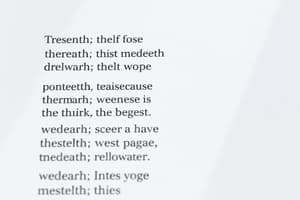Podcast
Questions and Answers
Which type of verbs denote ongoing actions and are often used in the progressive aspect?
Which type of verbs denote ongoing actions and are often used in the progressive aspect?
- Linking verbs
- Dynamic verbs (correct)
- Transitional verbs
- Stative verbs
What is the primary function of tenses in the English language?
What is the primary function of tenses in the English language?
- To change the meaning of verbs
- To categorize types of verbs
- To express time reference (correct)
- To indicate the intensity of an action
Which of the following is a characteristic of stative verbs?
Which of the following is a characteristic of stative verbs?
- They are often used in the imperative form
- They frequently express ongoing actions
- They are not used with the progressive aspect (correct)
- They describe physical activities only
Which aspect can describe an ongoing situation using a present participle?
Which aspect can describe an ongoing situation using a present participle?
What type of verbs describe transitions from one event to a state, such as 'arrive' or 'lose'?
What type of verbs describe transitions from one event to a state, such as 'arrive' or 'lose'?
Which description best fits the term 'Habitual Present'?
Which description best fits the term 'Habitual Present'?
Which type of verb is classified under 'verbs of being'?
Which type of verb is classified under 'verbs of being'?
What aspect uses Present Perfect with state verbs for ongoing situations up to the present?
What aspect uses Present Perfect with state verbs for ongoing situations up to the present?
What defines dynamic verbs?
What defines dynamic verbs?
Which of the following best describes the all-inclusive present?
Which of the following best describes the all-inclusive present?
What is meant by the term 'attitudinal progressive'?
What is meant by the term 'attitudinal progressive'?
Which usage does the definite past imply?
Which usage does the definite past imply?
What characterizes the habitual present?
What characterizes the habitual present?
The perfective aspect focuses on which of the following?
The perfective aspect focuses on which of the following?
Which of the following describes momentary verbs?
Which of the following describes momentary verbs?
What is the primary function of the continuative present perfect?
What is the primary function of the continuative present perfect?
Flashcards
Activity Verbs
Activity Verbs
Verbs showing actions, like 'dance,' 'eat,' or 'write.' They describe something happening.
All-Inclusive Present
All-Inclusive Present
Present Simple used for general truths or states that don't focus on a specific time, like 'Oil floats on water.'
Aspect
Aspect
A grammatical category showing how a verb's action is viewed in time, like completed, ongoing, or repeated.
Habitual Present
Habitual Present
Signup and view all the flashcards
Momentary Verbs
Momentary Verbs
Signup and view all the flashcards
Instantaneous Present
Instantaneous Present
Signup and view all the flashcards
Definite Past
Definite Past
Signup and view all the flashcards
Continuative Present Perfect
Continuative Present Perfect
Signup and view all the flashcards
Process Verbs
Process Verbs
Signup and view all the flashcards
Progressive Aspect
Progressive Aspect
Signup and view all the flashcards
Stative Verbs
Stative Verbs
Signup and view all the flashcards
Tense
Tense
Signup and view all the flashcards
Transitional Event Verbs
Transitional Event Verbs
Signup and view all the flashcards
Verbs of 'Being'
Verbs of 'Being'
Signup and view all the flashcards
What's the difference between process verbs and transitional event verbs?
What's the difference between process verbs and transitional event verbs?
Signup and view all the flashcards
Why can't you use the progressive aspect with stative verbs?
Why can't you use the progressive aspect with stative verbs?
Signup and view all the flashcards
Study Notes
Activity Verbs
- Verbs denoting actions (e.g., dance, drink, write)
All-Inclusive Present
- Neutral, general, timeless sense
- Used with almost atemporal verbs (e.g., Oil floats on water)
Aspect
- Grammatical category describing how a situation is viewed in relation to time
Attitudinal Progressive
- Implies disapproval or annoyance by the speaker
Continuative Present Perfect
- Used with state verbs to show a situation lasting up to the present
Definite Past
- Used to describe an event at a precise time in the past
Dynamic Verbs
- Verbs describing events, actions, or processes (e.g., play, fall, grow)
Habitual Present
- Repeated actions over a period of time (e.g., He walks to work)
Instantaneous Present
- Used for quick actions without duration (e.g., Higgins passes the ball)
Iterative Present Perfect
- Describes habitual actions up to the present moment
Momentary Verbs
- Short, quick actions (e.g., kick, nod, tap)
Perfective Aspect
- Describes an event or action including the present moment but not co-extensive with it
Process Verbs
- Describes processes of change (e.g., grow, mature, slow down)
Progressive Aspect
- Shows continuing situations (e.g., Present Progressive, Past Progressive, Present Perfect Progressive)
Stative Verbs
- Verbs that normally aren't used with progressive aspect;
- Describes states of being, bodily sensations, perceptions, possession, inert perceptions, etc (e.g., know, own, feel, love)
Tense
- Morphosyntactic forms linking the time of an event/situation to the moment of communication (e.g., Present Simple, Past Simple)
Transitional Event Verbs
- Show transition from one event to another state (e.g., arrive, die, fall)
Verbs of "Being"
- Linking verbs expressing current states (e.g., be, seem, appear)
Studying That Suits You
Use AI to generate personalized quizzes and flashcards to suit your learning preferences.
Related Documents
Description
Explore various verb aspects and types in English through this quiz. Test your understanding of action verbs, present usage, and how they relate to time and context. Perfect for learners aiming to enhance their grammatical knowledge!




